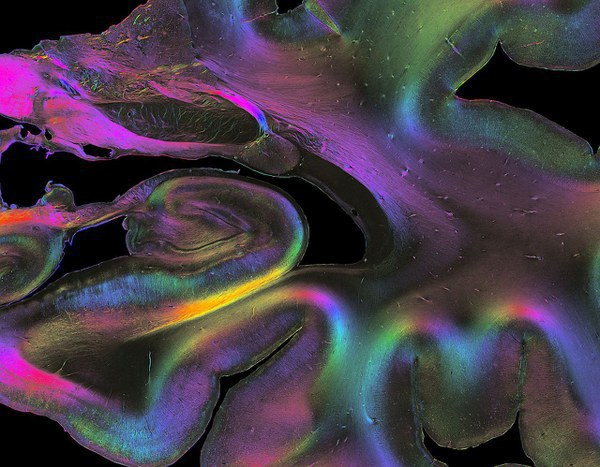25 April 2024
A position paper by over 100 authors, now published in the journal Imaging Neuroscience, summarizes the development of digital neuroscience, the current status and further goals in the new research field. In this interview, the lead author, internationally renowned brain researcher Prof. Katrin Amunts, gives an insight into the content and origins of the paper.

Prof. Amunts, why is brain research so demanding?
Katrin Amunts: The brain is one of the most complex systems known to man. We study the brain on several spatial and temporal scales - from individual molecules to the whole brain and subject-level. Furthermore, it changes and adapts throughout life - this happens within milliseconds to over the entire lifespan. The many different scales must be considered together to develop a comprehensive understanding of brain structure and function.
What changes have had a decisive impact on neuroscience in recent years?
The way in which brain research is conducted has changed fundamentally. Digital technologies and new instruments, tools and methods have transformed the field. One example is our three-dimensional brain atlas, which has now become a kind of Google Maps. It does not only offer detailed maps of the brain, but also a large amount of data and software to work with. Digitalisation has opened many doors between the "silos" of the various subdisciplines in brain research and brain-related fields in recent years. In addition, new, large-scale collaborations within Europe and worldwide are creating synergies based on the shared use of data and instruments. They thus take account of the great dynamism in research. The change has led to important advances and opens up new opportunities to advance brain research, medicine and brain-inspired technologies.
What is the background of the creation of the position paper?
The development of new digital methods is changing research rapidly, and in the case of AI and most recently, large language models, this is happening faster than many of us expected. These advances were made possible by stronger and more powerful computers, and digitalisation. We now have the basis to delve much deeper into research. At the same time, this also opens up new questions. It is crucial that we evaluate, anticipate and help shape such developments. In this way, we can maximize the opportunities and overcome the challenges of the next decade for research and its application, taking into account the ethical and social aspects. The paper provides the framework for this, a kind of "scientific roadmap".
The position paper was developed in several stages. How exactly?
Two years ago, the HBP initiated an open and collaborative exchange of scientific opinions and data for researchers around the world, resulting in the position paper that has now been published. A first version by around 40 scientists was published on the open publication platform Zenodo in March 2022, with a call for researchers outside the HBP in particular to contribute further perspectives. The paper grew from edition to edition. The fifth and final version with over 100 authors has now been published in the journal Imaging Neuroscience. They come not only from Europe, but also from the USA, Canada and Asia.
What are examples of goals for digital neuroscience in the coming decade?
The paper identifies a total of eight key areas for research. One example of a medical application is the so-called "digital twin": twins are computer-based, mathematical brain models that can be continuously updated with measurement data. They are not as similar to the original as they sound, as a model always means an abstraction. But even simplified models can help us to better understand specific mechanisms and are making predictions that can be clinically relevant. Personalized models will increasingly enable us to improve diagnostics and therapy. For example, research originating from the HBP is the basis to investigate the use of the "digital twin" for better planning of surgical interventions for epilepsy. Virtual brains also enable us to test fundamental research hypotheses about the organization of our most complex organ, and at the same time pave the way for innovative neuro-inspired technologies.
What role does the EBRAINS research infrastructure play in this?
EBRAINS emerged from the work of the HBP. This new digital and collaborative research infrastructure enables the integration of data provided by different research groups from different countries and with different approaches, and makes it accessible to others for their research projects. EBRAINS offers a wide range of different digital tools and services to support neuroscientists, that can be combined in a flexible way. Compute- and data- intensive workflows can make use of powerful European supercomputers such as those of the Jülich Supercomputing Center JSC, the CEA in France or CINECA in Italy, which are part of a dedicated compute infrastructure called Fenix.
What will be the relation between artificial intelligence (AI) and neuroscientific research over the next ten years?
AI-based methods are becoming a more and more powerful tool for neuroscientists. Foundation models are changing research in a way that is expected to address completely new questions. At the same time, we should explore how to overcome some of the limits that these methods have, e.g., by learning from the brain. Such a transfer has happened already. Some neuro-inspired networks have already shown remarkable characteristics, for example, they learn faster and with less training data. Findings from brain research are also being applied to the development of new hardware - for example, in BrainScaleS and SpiNNaker, which are among the most powerful neuromorphic systems today. They emerged from the HBP and have shown very intriguing advantages in domains like real-time processing and energy efficiency. Now they are available on EBRAINS.
Original publication: K. Amunts et al., The coming decade of digital brain research. A vision for neuroscience at the intersection of technology and computing. Imaging Neuroscience (2024)
Executive Summary: PDF file











